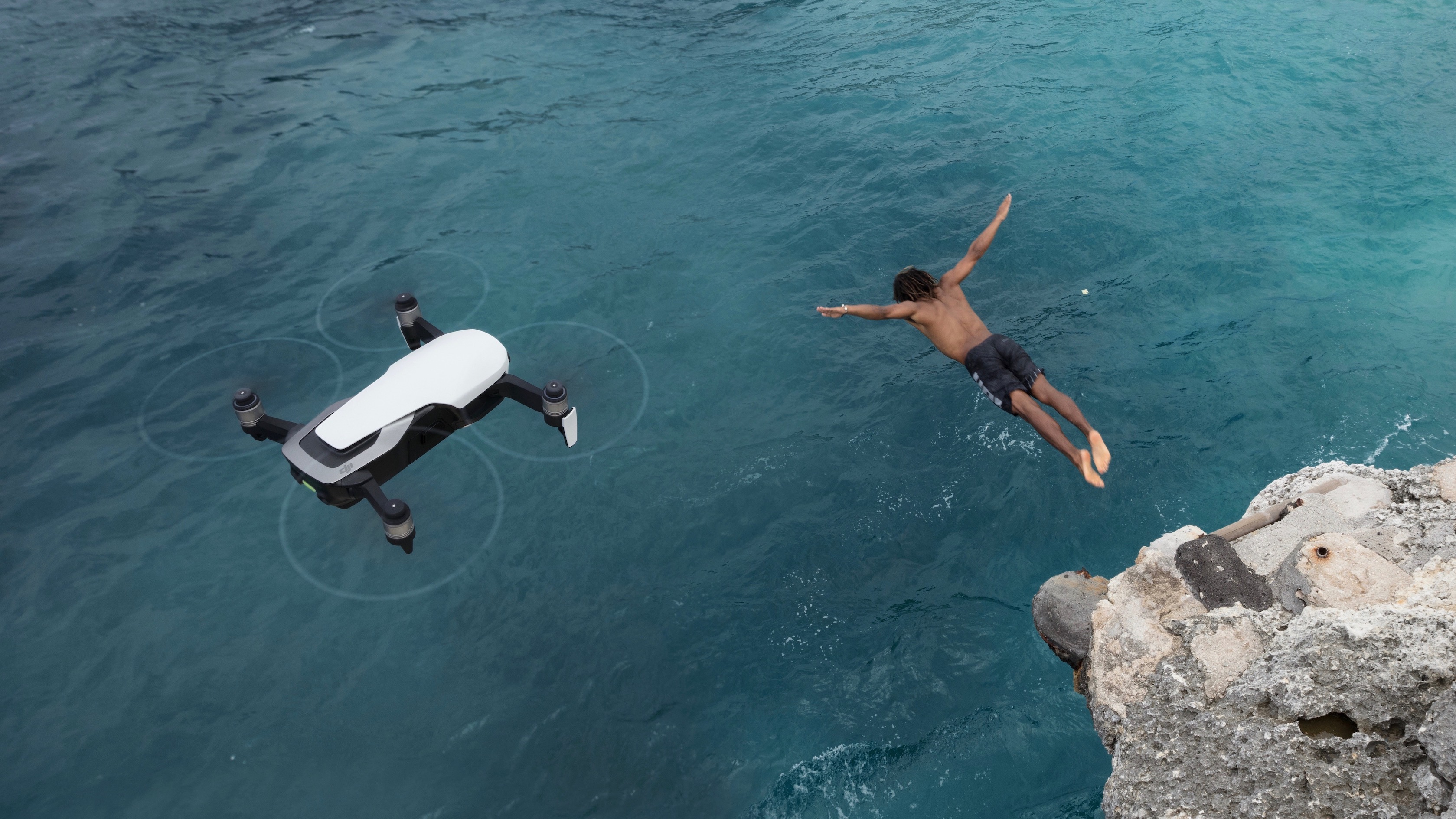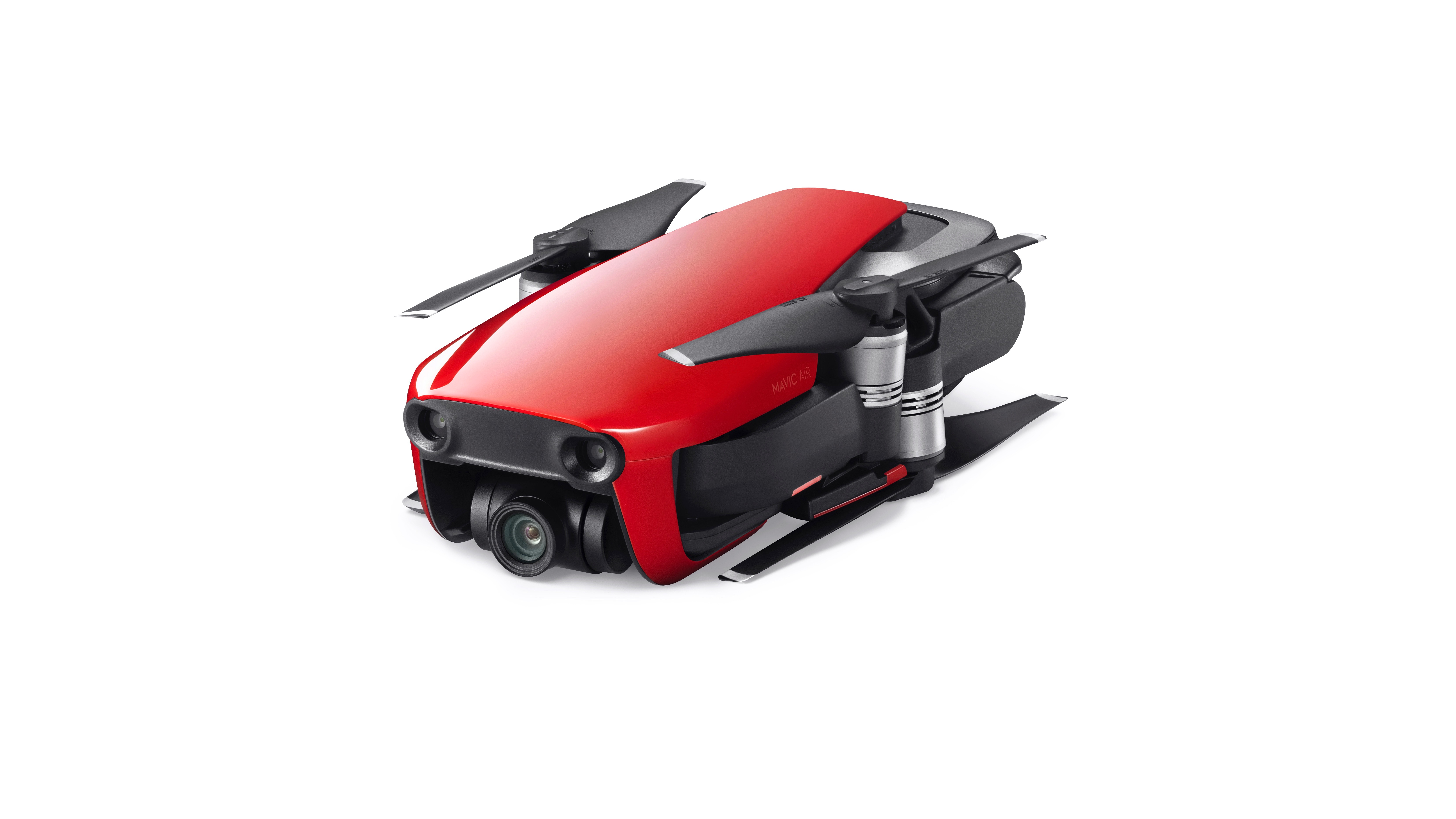DJI Mavic Air review: impressively portable and efficient
The DJI Mavic Air boasts impressive ease of use, smooth, 3-axis gimbal, gesture controls and smart capture of stunning 4K footage. Here's our review


The Mavic Air is a true pocket rocket that excels in every department. It’s much lighter and smaller than the DJI Mavic 2 Pro and not much bigger than its smaller sibling, the Spark. Figure in the four folding rotor arms and you have an extremely portable and efficient 4K camera-equipped drone.
-
+
Impeccably compact and portable
-
+
Smooth 4K video
-
+
Gesture controls
-
-
Battery life could be better
-
-
No side sensors
Why you can trust T3
DJI is pretty much the king of the skies already these days, when it comes to drones. It dominates our best drones list, and yet it keeps pressing onward - and upward - progressing with more and more impressive drones. That doesn’t just mean new camera tricks but also condensed portability and safer flying.
The Mavic Air can see the world around it to make flying easy for beginners but has a fancy controller that can keep even pros entertained. What's really special here is the myriad camera options that let you get high quality helicopter-style shots for the price of a drone. From swooping videos, to movement tracked shots, to eye-opening panoramas, it has lots to offer. Gesture controls, a 4K video and steady gimbal quality photos just enhance the experience.
The DJI Mavic Air encapsulates all of this and promises to leave your jaw agape, and not just because you’re looking up. But these are all claims – did our hands-on time with the new drone prove them to be accurate? And is all that worth the £769 price tag?
Note: there are newer versions of this drone! Check out our DJI Air 2S review for the latest model, or our DJI Mavic Air 2 review for the one in the middle.
- Too expensive? These are the best cheap drones
- ... and the best drones for kids
- DJI Mavic 2 Pro review
DJI Mavic Air review: design

DJI Mavic Air folded
This is the smallest and lightest smart drone yet. That means it's not as big as the Mavic Pro but it’s still a bit larger than the positively micro toy that is the Spark. One reason this is a class above the Spark is thanks to a 3-axis all-mechanical gimbal that means the camera pictures and videos are super sharp even when flying at speed or hovering in wind.
The camera on the front isn’t the only one on this drone though, there are location scanning cameras also. You have two on the front, two on the bottom and two in the rear, all to detect the world around - something that comes in handy for the obstacle avoidance, but more on that later.
The DJI Mavic Air weighs in at a svelte 430g, which feels like a tablet’s weight when in the hand. It folds down, with an easy flip of the propeller shafts, into a package that sits comfortably in the hand. This is small enough to throw in a bag but is still a bit too bulky to be crammed into a trouser pocket. When you consider how much tech is crammed into this beauty, it really is impressive to look at. The fact it looks like a badass little fighter plane when folded up is just a bonus.
Get all the latest news, reviews, deals and buying guides on gorgeous tech, home and active products from the T3 experts
The controller is also compact and folds down small enough to fit in a pocket. This is thanks to the removable joysticks which slip into the body as it folds down. Yet the folded out remote is as comfortable as any console controller and features even more buttons for super complex controls if you need them, but is still really easy to access for newbs.
DJI Mavic Air review: camera features

Back to the main camera. This features a 1/2.3-inch CMOS sensor with equivalent 28mm f/2.8 aperture lens for 12-megapixel stills. Video runs at 4K with 30 fps and a 100 Mbps bitrate or at 1080p with a 120 fps slow motion. The addition of 8GB storage onboard means you can capture footage without an SD card. But this also means adding or swapping out SD cards is a more seamless process now. That’s something you’ll need to do when you consider that a 4K 30 fps video of two minutes will chew through a good 1.5 GB of data.
The image offerings aren’t just straight photos though, you can now use even more smart camera modes. For panoramas there are options for vertical, horizontal and 180 degree images, which the drone stitches together for you. You just tap to find the mode and select to take, then the drone will move itself about taking shots to stitch together the finished product. The extreme version of this, called Sphere Panorama, stitches together 25 photos for a 32-megapixel panorama in just a minute. In real world use the edit took a little longer to appear as finished.
A new video mode, called Boomerang, takes the drone out from the subject, up and around behind them and back to the start as a way to capture the subject and the surrounding area perfectly. Another cool video mode, called Asteroid, takes a spherical image from on high then zooms and twists into the subject on the ground creating an effect as though you’re flying down from space on - you guessed it - an asteroid. A nice touch here is that the drone does this all in reverse so you only need to pose at the start before it takes off to shoot the spherical images on high. It then plays back the footage from top to bottom.
DJI Mavic Air review: flight controls

DJI Mavic Air gesture controlled
No matter how compact and impressive the controller is we’ll always get a kick out of flying a drone using hand gestures. The Mavic Air is super accurate and manages to follow hand swipes, mimicking the movements, even when surprisingly far away. This might sound like a gimmick but is actually a really handy way to get photos and videos without digging out the controller. You can even take off and land using gestures, leaving the controller out of any photo or video selfies.
Gestures are great fun too. To take a pic simply throw up the classic V sign with your fingers and it'll take a snap. Or if you want to record a video, you make a framing shape, as if you were a director checking the framing of a shot, and the drone will get filming. This second one was a bit less easy to get working every time, but the picture gesture control was excellent. The flashing of the drone’s lights to confirm pics and videos is another nice touch.
A lot of this gesture controlled flight is made possible by the automated flying abilities of the Mavic Air. This thing hovers perfectly, ideal for photos, but it also tracks you as you move about. So far so standard DJI. The new feature is an ability to follow more than one person, which is a nice idea if two people are cycling, snowboarding or running together. This won’t work if you’re both off in different directions - it also won’t make the drone lose it’s mechanical mind and self-destruct – we tried.
The seven cameras and infrared sensors constantly scan the surrounds so that the drone, using the new FlightAutonomy 2.0 algorithms, can dodge obstacles and keep flights safe. This is a really nice safety net when you’re playing with this expensive bit of kit - it just makes you feel safer so you can actually enjoy the experience rather than constantly worrying about breaking the thing. That said, it doesn’t have side sensors, so if the drone is swinging around in a circle to capture that Boomerang shot you do have to be sure there isn’t a tree in the way or you’ll likely be climbing that thing to get your drone back.
DJI Mavic Air review: other features

The DJI Mavic Air in flight mode
On a full charge the Mavic Air will keep flying for around 21 minutes. This seemed about right from the use we had with the drone. However that was in very good flying conditions. If it’s windy you’ll end up chewing through power faster. Spare batteries are definitely advisable (£69 each).
The drone has a range of 2.5 miles but even with the sea in front of us we didn’t get to anywhere near that. It certainly is fast though with a normal speed of 22 mph or in sport mode an eye-darting 42 mph. While we didn’t get to try this with the DJI Goggles we imagine that would be a pretty intense experience, even with the safety of object avoidance spotting hazards at 20 metres away. Mind, it is quite a noisy little thing that will likely attract attention if flown at lower altitudes.
The DJI Mavic Air drone with battery, remote controller, carrying case, two pairs of propeller guards and four pairs of propellers is priced at £769. But the Mavic Air Fly More Combo includes the drone, three batteries, a remote controller, a travel bag, two pairs of propeller guards, six pairs of propellers, a battery to power bank adapter and battery charging hub, for £949.
DJI Mavic Air review: verdict

Fly, my pretty!
If you want a drone then the Mavic Air is arguably the best out there. It has the smarts of the top end Phantom drones, the foldable portability of the Mavic 2 Pro and the gesture controls of the Spark. For a do-it-all drone device, this is the perfect middle ground that will suit most users.
If you’re a pro then you probably want to shell out more for the Mavic 2 Pro, Inspire 2 or a Phantom Pro. And if you’re at the other end of the spectrum and only want a drone for some casual fun, the super small Spark is probably enough. But if you want it all then the Mavic Air is ideal. Top marks all round.
Luke is a freelance writer for T3 with over two decades of experience covering tech, science and health. Among many things, Luke writes about health tech, software and apps, VPNs, TV, audio, smart home, antivirus, broadband, smartphones and cars. In his free time, Luke climbs mountains, swims outside and contorts his body into silly positions while breathing as calmly as possible.


